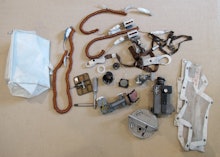A Bunch of Long Lost Moon Souvenirs Were Just Discovered in Neil Armstrong's Closet

Who knew that a closet in Cincinnati, Ohio, would hold mementos from humankind's most important adventure in space?
The National Air and Space Museum recently became the proprietors of an astonishing collection — some 20 artifacts that were aboard Apollo 11's lunar module, Eagle, which was the first vehicle to land humans on the moon.
In a Feb. 6 blog post, Allan Needell, a curator in the museum's Space History Department, said the heirlooms, all packed away in a white cloth bag, were discovered after Neil Armstrong's widow, Carol, invited museum curators to parse through the belongings in her husband's office in Cincinnati. A few weeks after they left, she wrote to them with news that she had uncovered something else — a bag full of Armstrong's "souvenirs" from the historic moon landing squirreled away in the back of a closet.
"Needless to say, for a curator of a collection of space artifacts, it is hard to imagine anything more exciting," Needell wrote after seeing a photo of the objects, which included the camera that recorded the landing and Armstrong's famous "one small step" line.
The items — detailed descriptions of which can be found here — were previously unknown to just about everyone. "As far as we know, Neil has never discussed the existence of these items and no one else has seen them in the 45 years since he returned from the moon," wrote Needell.
The bag's contents are particularly significant because they were never supposed to make it back to Earth — they were originally destined to stay in the Eagle, which continued its lunar orbit for a time and is now assumed to have crashed into the moon's surface.
But according to a transcript of a conversation between Armstrong and Buzz Aldrin, the bag of stuff was intentionally brought back. "You know, that — that one's just a bunch of trash that we want to take back — LM parts, odds and ends, and it won't stay closed by itself. We'll have to figure something out for it," Armstrong was heard saying.
Besides the camera, the white cloth bag also included an emergency wrench, a mirror, a helmet tie-down strap, a light bulb assembly, a waist tether, a separate lens for the camera, a utility light and a power cable, among other objects.
Needell noted that two of the "odds and ends" — the camera and the waist tether — are on display as part of a temporary exhibit at the National Air and Space Museum in Washington, D.C. But he also emphasized that he and the other curators hope to one day open up the entire collection to the public.
"Seeing such things with one's own eyes helps us to appreciate that these accomplishments are not just in history books or movies, but involved real people and real things, and that they involved an extraordinary amount of detailed engineering and planning," Needell wrote.
h/t Washington Post